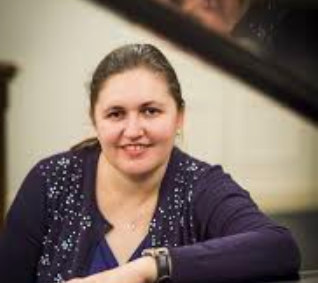Regina Shenderovich in Review
Regina Shenderovich, piano
The National Opera Center-OPERA America, Marc A. Scorca Hall, New York, NY
January 28, 2020
There’s a first time for everything—I’ll explain shortly. Pianist Regina Shenderovich had the inspired idea of presenting Baroque and neo-Baroque music on the same program. Three toccatas: Frescobaldi (Toccata Nona in F Major from Il secondo libro di toccata) and Froberger (Toccata II in D Minor, FbWV102, from Libro Secondo ), two predecessors of Bach, then genuine Bach (Toccata in E minor, BWV 914), followed by the complete first half of Shostakovich’s monumental Preludes and Fugues, Op. 87. Here’s the first time: In all my years as a performer, listener, and critic, I have never heard either Frescobaldi or Froberger on a piano recital! Organ recitals, yes, harpsichord yes, but piano, never. This alone signals an unusual level of curiosity in Ms. Shenderovich.
The recital took place in the rather acoustically live hall of the National Opera Center. I don’t know what was done in terms of promoting the event, but it’s a shame that more people were not in attendance to hear it—it was free. The bare-bones program listed no biographical information, so I had to Google to find out that Ms. Shenderovich was trained in Saint Petersburg (Russia), and that she has bachelor’s, master’s, and doctoral degrees in piano from Boston Conservatory, Peabody Conservatory, and University of Illinois, respectively; and that she has studied with some of the finest teachers and performers. Ms. Shenderovich dedicated her program to the memory of her grandmother.
Her innovative program was played with great commitment and more than enough technical fluidity. The massive Shostakovich group was played from score—no objection here, though I do expect greater accuracy when using the music. The recital was marred by a certain tendency to rush, or not hold long notes or rests for their full value, all of which gave the music a perfunctory quality, though I could see her emotional involvement. Ms. Shenderovich’s left hand was not fully grounded, often failing to sound, or, when it did, failing to provide needed resonant support for the treble. As I need to say so often in these pages, there was insufficient attention paid to dynamics of piano and pianissimo; though every so often Ms. Shenderovich would create a magical soft sound, contrasting with her customary boisterous approach.
The group of Baroque toccatas suffered from the left-hand issue, particularly the Bach, and there was just not enough sonic variety: after all, if we’re using the modern piano, let’s go for it. Her trills and ornaments were quite admirable, however.
It is an honor just to be in the ‘same room’ as the Shostakovich, which was inspired by his serving on the jury of the first-ever Leipzig international Bach competition, held on the 250th anniversary of Bach’s death, and was won by Tatiana Nikolaevich, to whom the works were dedicated, and who premiered them and carried them across the globe for decades.
For me, the standouts of Ms. Shenderovich’s Shostakovich were several of the Preludes: the A minor, E minor, B minor (dotted rhythms of the French overture), E major, and C-sharp minor, in which her technique and passion were best united. The C major prelude lacked the tenderness of the sarabande; its fugue should peak at a mezzo-forte. Many of the fugues were taken too fast, and lacked the laser-focused contrapuntal clarity that makes them transparent. The best fugue was the final one in G-sharp minor, whose many subject entries were audible, though still lacking enough pianissimo. The G major fugue was a close second, with its jaunty subject highlighting Ms. Shenderovich’s strengths. A majority of the fugues, as specified in the score, begin quite softly and do not increase in dynamics, often for many measures. With Ms. Shenderovich’s inflated dynamics, many of them sounded like character pieces that contained ‘some’ counterpoint, instead of the encyclopedia of twentieth-century polyphonic ingenuity that they are. (An arguable approach?)
Notwithstanding my complaints above, Ms. Shenderovich’s performance allowed me to perceive the many intricate thematic relations among the preludes and fugues, with ‘tonic-dominant-sixth scale degree’ recurring in striking fashion, not surprising in a work composed fairly quickly, out of the same laboratory of the mind that belonged to Dmitri Shostakovich. I hope that Ms. Shenderovich will continue her work with the cycle (also the second half!), refining her deep listening and ability to bring out the contrapuntal beauties while placing some competing voices on a different sonorous level, and adding that indefinable contemplative quality which reveals the inner tragedy never far from the surface in Shostakovich. She is well on the way to acquiring something our world urgently needs to hear.

